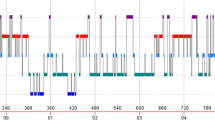Summary
The aim of the present study was to investigate whether the ovulation-maintaining effect of melatonin in rats, exposed to continuous light (LL), was also exerted by other pineal indoles which have been reported to influence the reproductive processes of mammals. The effect of 10μg melatonin was compared with that of similar amounts of either N-acetylserotonin, 5-methoxytryptophol, 5-methoxyindole-3-acetic acid, 5-hydroxytryptophol, 5-methoxytryptamine or 5-methoxytryptophan. All these compounds appeared to be significantly less effective than melatonin in preventing the effect of LL, ovulation being preserved in only 20–33 % of the rats investigated, with melatonin this percentage being 60–75%.
Investigations were also carried out to assess the effect of these indole derivatives on HIOMT (hydroxyindole-O-methyl transferase) activity in synthesizing different 5-methoxyindoles in the abnormally influenced pineal gland due to LL. Melatonin, the compound the effect of which on ovarian cyclicity is strongest, stimulates 5-methoxytryptophol synthesis; while other less active compounds stimulate the synthesis of melatonin and inhibit that of O-acetyl-5-methoxytryptophol. The possibility that the effect of other indoles than melatonin on ovarian cyclicity might be due to stimulation of melatonin synthesis was considered. A possible functional relationship of the different indoles cannot be excluded.
Similar content being viewed by others
References
Balemans, M. G. M.: Age-dependent effects of 5-methoxytryptophol and melatonin on testes and comb growth of the white leghorn (Gallus domesticus L.). J. Neural Transm.33, 179–194 (1972).
Balemans, M. G. M.: The inhibitory effect of 5-methoxytryptophol on ovarian weight, follicular growth and egg production of adult white leghorn hens (Gallus domesticus L). J. Neural Transm.34, 159–169 (1973).
Balemans, M. G. M.: The indole metabolism in the pineal gland. Prog. Brain Res.52, 222–229 (1979).
Balemans, M. G. M., Van de Veerdonk, F. C. G., Van de Kamer, J. C.: Effect of injecting 5-methoxyindoles, pineal compounds, on testicular weight of white leghorn cockerels (Gallus domesticus L.). J. Neural Transm.41, 47 to 57 (1977).
Balemans, M. G. M., Bary, F. A. M., Legerstee, W. C., Van Benthem, J.: Estimation of methylating capacity in the pineal gland of the rat with special reference to the methylation of N-acetylserotonin and 5-hydroxytryptophol separately. Experientia34, 1434–1435 (1978).
Browman, L. G.: Light in its relation to activity and estrous rhythm in the albino rats. J. exp. Zool.75, 375–388 (1937).
De Gaetani, C. F., Poggioli, R., Ferrari, P., Mess, B., Trentini, G. P.: Is the role of melatonin in induction of ovulation in the light-induced constant estrous anovulatory state mediated through the brain serotonergic system? Reprod. Nutr. Dévelop.20, 1893–1898 (1980).
Fiske, V. M., Huppert, L. C.: Melatonin action on pineal varies with photo-period. Science162, 279 (1968).
Fiske, V. M., Bryant, K., Putnam, J.: Effect of light on the weight of the pineal in the rat. Endocrinology66, 489–491 (1960).
Fraschini, F., Martini, L.: Rhythmic phenomena and pineal principles. In: The Hypothalamus (Martini, L., Motta, M., Fraschini, F., eds.), pp. 529 to 549. New York-London: Academic Press. 1970.
Fraschini, F., Collu, R., Martini, L.: Mechanisms of inhibitory action of pineal principles on gonadotropin secretion. In: The Pineal Gland (Wolstenholme, G. E. W., Knight, J., eds.), pp. 259–273. London-Edinburgh: Churchill Livingstone. 1971.
Hemmingsen, A. M., Krarup, N. B.: Rhythmic diurnal variations in the oestrous phenomena of the rat and their susceptibility to light and dark. Kgl. Danske Videnske Selskab. Biol. Med.13, 7–13 (1937).
Klein, D. C., Weller, J. L.: Indole metabolism in the pineal gland: a circadian rhythm in N-acetyltransferase. Science169, 1093–1095 (1970).
McIsaac, W. M., Taborsky, R. G., Farrell, G.: 5-methoxytryptophol: Effect on estrus and ovarian weight. Science145, 63–64 (1964).
Pévet, P., Haldar-Misra, C., Öcal, T.: Effect of 5-methoxytryptophan and 5-methoxytryptamine on the reproductive system of the male golden hamster. J. Neural Transm.51, 303–311 (1981).
Reiter, R. J.: The role of the pineal in reproduction. In: Reproductive Biology (Balin, H., Glasser, S., eds.), pp. 71–114, Amsterdam: Excerpta Medica. 1972.
Reiter, R. J., Vaughan, M. K., Blask, D. E., Johnson, L. Y.: Pineal methoxy-indoles: new evidence concerning their function in the control of pineal-mediated changes in the reproductive physiology of male golden hamsters. Endocrinology96, 206–213 (1975).
Sackman, J. W., Little, J. C., Rudeen, P. K., Waring, P. J., Reiter, R. J.: The effects of pineal indoles given late in the light period on reproductive organs and pituitary prolactin levels in male golden hamsters. Horm. Res.8, 84–92 (1977).
Smith, I.: Concluding remarks. In: The Pineal, Vol. 6 (Reiter, R. J., ed.), pp. 209–213. St. Albans: Eden Press. 1981.
Trentini, G. P., Mess, B., De Gaetani, C. F., Ruzsás, Cs.: Effect of melatonin on induction of ovulation in the light-induced constant estrous anovulatory syndrome and possible role of the brain serotoninergic system. J. Endocrinol. Invest.1, 305–310 (1978).
Trentini, G. P., Mess, B., De Gaetani, C, F., Poggioli, R., Ferrari, P., Di Gregorio, C.: The role of melatonin and brain serotonergic system in the maintenance of rat ovarian cyclicity. In: Pineal Function (Matthews, C. D., Seamark, R. F., eds.), pp. 77–86. Amsterdam: Elsevier. 1981.
Weiss, B.: Discussion on the formation, metabolism and physiologic effect of melatonin. Adv. Pharmacol.6 A, 152–155 (1968).
Wurtman, R. J., Axelrod, J., Phillips, L. S.: Melatonin synthesis in the pineal gland: control by light. Science142, 1071–1073 (1963).
Author information
Authors and Affiliations
Rights and permissions
About this article
Cite this article
Trentini, G.P., De Gaetani, C.F., Criscuolo, M. et al. The effect of melatonin and other indole derivatives in maintaining ovulation in rats kept in continuous light and the influence of these indoles on HIOMT activity in the pineal gland. J. Neural Transmission 53, 305–314 (1982). https://doi.org/10.1007/BF01252041
Received:
Issue Date:
DOI: https://doi.org/10.1007/BF01252041




